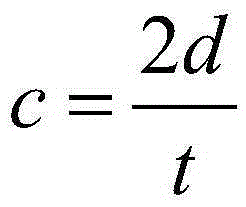A method for identifying multiple metals by ultrasonic non-destructive detection
A non-destructive detection and metal technology, which is applied in the preparation of test samples and the analysis of solids using sound waves/ultrasonic waves/infrasonic waves. Accurate and reasonable identification results
- Summary
- Abstract
- Description
- Claims
- Application Information
AI Technical Summary
Problems solved by technology
Method used
Image
Examples
Embodiment 1
[0023] Taking stainless steel, 304 stainless steel and 2A13 aluminum alloy as examples, the method of identifying these three metals by ultrasonic nondestructive detection consists of the following steps:
[0024] (1) Polish and clean the rectangular stainless steel, 304 stainless steel and 2A13 aluminum alloy reference samples with a thickness of 30 mm respectively;
[0025] (2) Fix the transceiver probes with a frequency f1 of 5MHz on the surfaces of the above three reference samples respectively, transmit a pulse signal with a frequency of 5MHz and collect the bottom reflection signals of the three reference samples. This example uses a commercially available 5077PR pulse Transmitting and receiving instrument and Puyuan RIGOLDS1052E digital oscilloscope process the collected reflection signal and send it to the computer for further processing, measure and calculate the sound velocity, sound attenuation coefficient and peak value of the primary bottom echo in the amplitude sp...
Embodiment 2
[0048] Now take the stainless iron sample as an example, put it at room temperature, 800°C|260°C / h↑|6h (heating treatment at 260°C per hour, heat preservation for 6 hours when the temperature rises to 800°C, natural cooling), 900°C| 260°C / h↑|6h (heat treatment at 260°C per hour, heat preservation for 6 hours when the temperature rises to 900°C, and natural cooling) Three samples under three heat treatment conditions were identified by ultrasonic non-destructive detection method. The method is as follows The steps consist of:
[0049] (1) For the known stainless iron reference samples under normal temperature conditions, the stainless iron reference samples under the conditions of 800°C|260°C / h↑|6h, and the conditions of 900°C|260°C / h↑|6h The surface of the stainless steel reference samples was polished and cleaned respectively.
[0050] (3) Take samples 1H-1, 1H-2, and 1H-3 as samples to be tested, and grind and clean their surfaces respectively so that the surface roughness ...
Embodiment 3
[0054] In step (2), the transceiver probes with a frequency f1 of 2.5 MHz are respectively fixed on the surfaces of the above three reference samples, a pulse signal with a frequency of 2.5 MHz is transmitted and the bottom reflection signals of the three reference samples are collected, measured and calculated The sound velocity, sound attenuation coefficient, peak frequency and bandwidth of a back-wall echo in the amplitude spectrum and the peak frequency and bandwidth of a back-wall echo in the power spectrum of each reference sample are obtained. In step (5), use a transceiver probe with a frequency f2 of 5 MHz, repeat steps (2) and (3), and obtain the sound velocity, sound attenuation coefficient, and amplitude spectrum of the reference sample and the sample to be tested under the condition of f2. The peak frequency and bandwidth of a backwall echo and the peak frequency and bandwidth of a backwall echo in the power spectrum are compared again with the parameters of the re...
PUM
 Login to View More
Login to View More Abstract
Description
Claims
Application Information
 Login to View More
Login to View More - R&D
- Intellectual Property
- Life Sciences
- Materials
- Tech Scout
- Unparalleled Data Quality
- Higher Quality Content
- 60% Fewer Hallucinations
Browse by: Latest US Patents, China's latest patents, Technical Efficacy Thesaurus, Application Domain, Technology Topic, Popular Technical Reports.
© 2025 PatSnap. All rights reserved.Legal|Privacy policy|Modern Slavery Act Transparency Statement|Sitemap|About US| Contact US: help@patsnap.com



